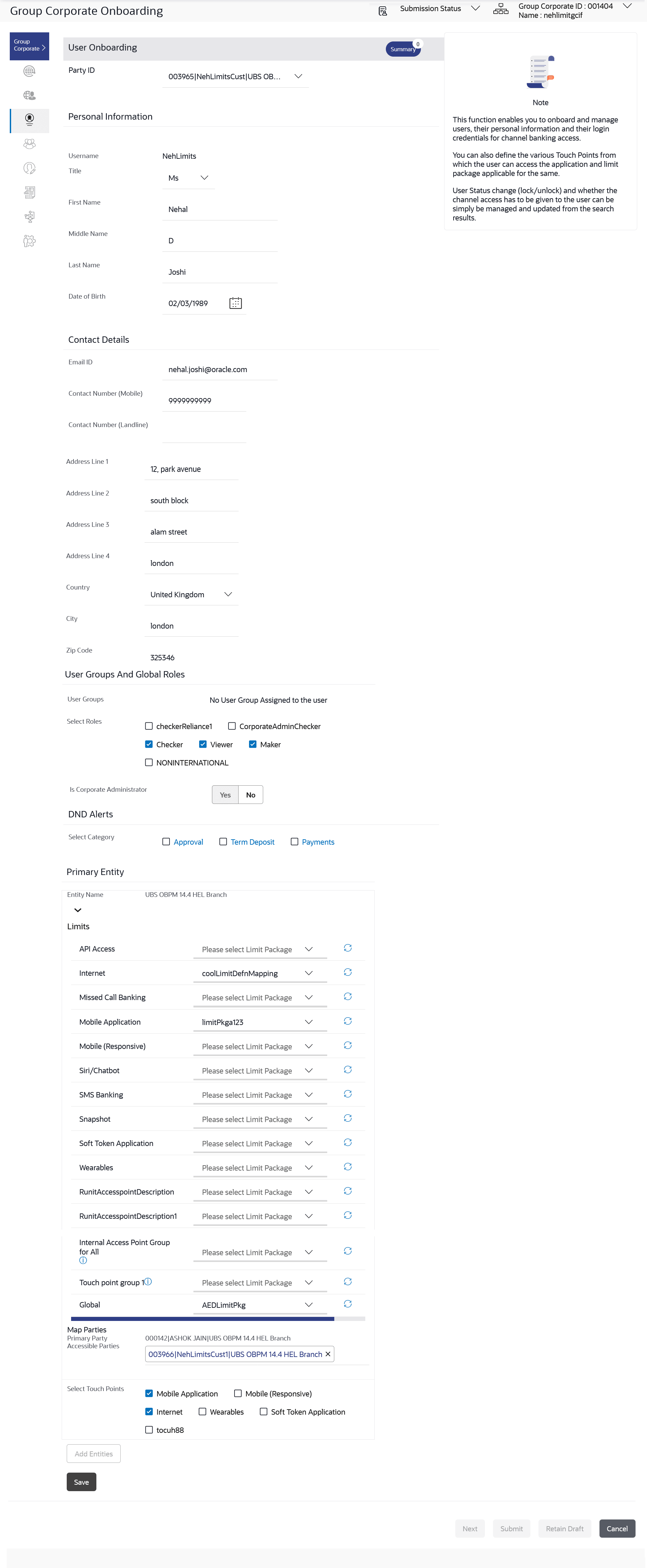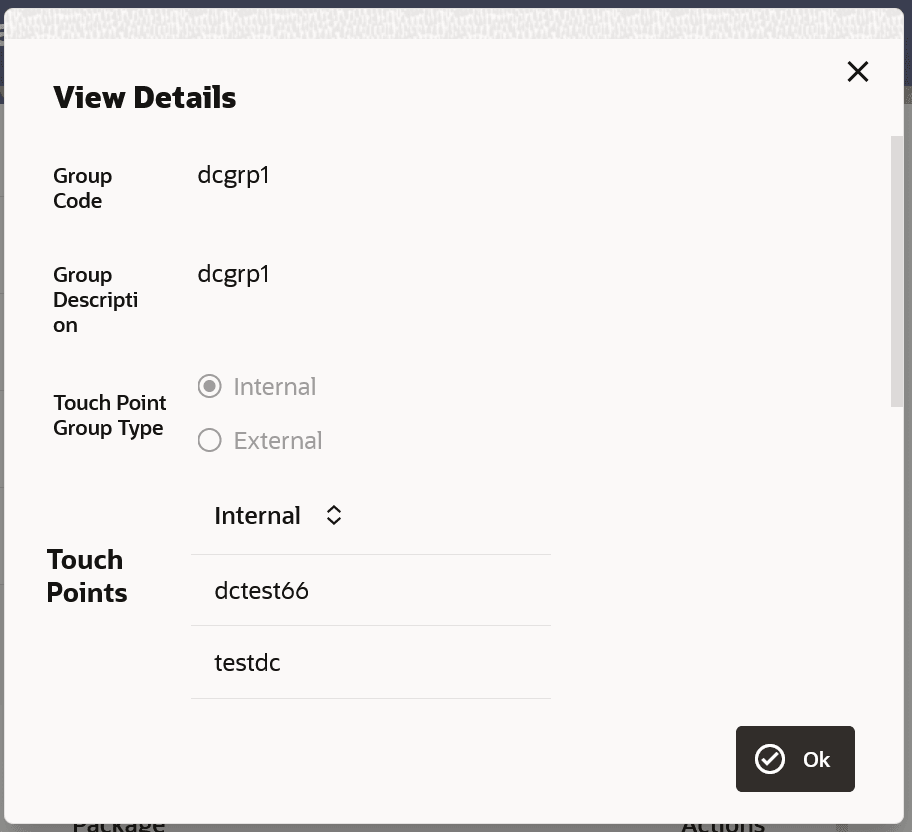3.6.2 User Management - Edit
This topic provides the systematic instructions to corporate administrators for modifing existing user details.
To edit or update a user details:
- Navigate to the User Onboarding screen.
- Perform one of the following actions:
- Enter the search criteria and click
Search.
The search results appear on the User Management screen based on the search parameters.
- Click Clear if you want to reset the search parameters.
- Click Cancel to cancel the transaction.
- Enter the search criteria and click
Search.
- In the User Management - Search Results section, click
the User Name link of the record for which you want to
edit the user details.The User Management - View screen appears.
- Click the Edit to update the user information.
Note:
The fields which are marked as Required are mandatory.For more information on fields, refer to the field description table.
Table 3-12 User Management – Edit- Field Description
Field Name Description Edit Party ID Party ID for which the user is created will be displayed. Personal Information User Name Name of the user (login ID) of the user. Title Title of the user. The options are:- Mr
- Mrs
- Miss
- Ms
- Dr
- Master
First Name First name of the user. Middle Name Middle name of the user. Last Name Last name/ surname of the user. Date of Birth Date of birth of the user. Contact Details Email ID Email id of the user. Contact Number (Mobile) Mobile number of the user. Contact Number (Land Line) Phone number (land line) number of the user. Address Line 1-4 Address of the user. Country Country of the user. City City in which the user resides. Zip Code The postal code of the city in which the user resided. Roles Application roles mapped to the user. In case of multi entity setup, these roles will be for the default/home entity of the user.
User Groups And Global Roles User Groups The list of all user groups to which the selected user belongs. Note:
- This information is read-only and hence cannot be modified.
- If a particular user needs to be removed from a user group, then the administrator must manually go to the particular user group screen and remove the user.
Roles The global roles which are mapped to the users. DND Alerts Category The list of categories for which DND is configured can be enabled or disabled using this option. Primary Entity Entity Name Name of the primary entity. Map Parties Primary Party Name of the primary party along with the group corporate code and entity name. Accessible Parties Accessible parties along with the group corporate code and entity name associated to the user. Limits Limits package associated to the user. Touch Points Name of touch points/ groups maintained under a specific entity for which the limit packages are mapped. Map Roles The roles to which the entities are mapped. Accessible Entity Details Entity Name Accessible Entity name associated to the user. Map Parties Primary Party Primary Party ID details of the user is associated with the New Entity. Accessible Parties Name Accessible Party Details that user has access. Limits - Touch Point/Groups Limits package associated to the user for the accessible entity.
Touch Points/ Group Name of touch points/ groups maintained under a specific entity for which the limit packages are mapped. Map Roles The roles to which the entities are mapped. - In the User Name field, enter the required details. Click Check Availability to check the uniqueness of the user ID. If the user ID is already used.
- In the Personal Information section, enter the required details.
- In the Contact Details section, enter the required details.
- In the Roles section, Select the checkbox (s) against the Roles, to map to the user.
- In the Touch Points section, select the touch points to be mapped to user.
- In the Accessible Entity Details section, add the
accessible entities for the user and select the party and limits for that entity
(applicable only if Bank has Multi Entity setup).
- Click Add Entity button, to add accessible entity to a user.
- In the Limits section, select the appropriate limit package under the Package for each touch point column.
- In the Primary Party ID field, select the Primary Party ID details of the user is associated with the New Entity
- From the Accessible Party Details, select the parties to map with user.
Figure 3-23 Touch Points Group - View Details
Note:
The fields which are marked as Required are mandatory.For more information on fields, refer to the field description table.
Table 3-13 Touch Points Group - View Details- Field Description
Field Name Description Group Code Group code defined for touch point group. Group Description Group description defined for touch point groups. Group Type Type of touch point i.e. whether touch point is of type internal or external. Touch Points List of the internal or external touch points. - Perform one of the following actions:
- Click Save to save the
maintenance.
The Review screen appears.
- Click Cancel to cancel the transaction.
- Click Back to navigate back to previous screen.
- Click Next to proceed to the next logical step
- Click Submit to submit the steps performed so far for approval.
- Click Retain Draft to save the details entered as draft.
- Click Save to save the
maintenance.
- Perform one of the following actions from the Review
screen:
- Verify the details, and click
Confirm.
The success message of updates appears.
- Click Cancel to cancel the operation.
- Click Back to navigate to the previous screen.
- Verify the details, and click
Confirm.
Parent topic: Step 3: User Onboarding

